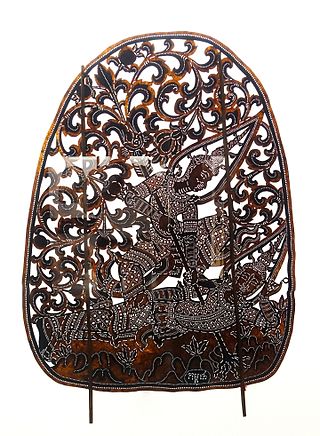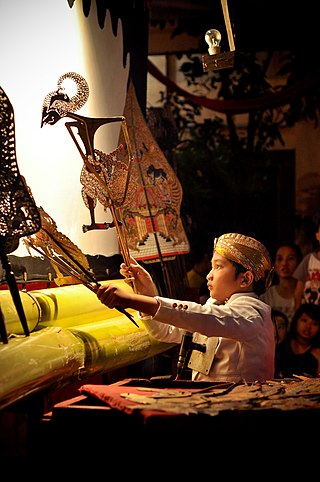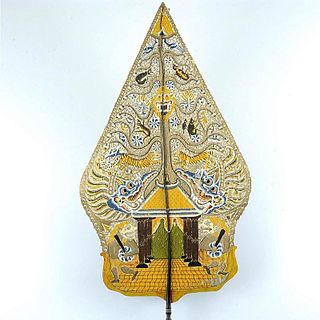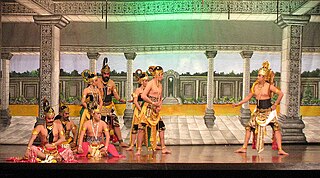
Central Java is a province of Indonesia, located in the middle of the island of Java. Its administrative capital is Semarang. It is bordered by West Java in the west, the Indian Ocean and the Special Region of Yogyakarta in the south, East Java in the east, and the Java Sea in the north. It has a total area of 33,750.37 km2, with a population of 36,516,035 at the 2020 Census making it the third-most populous province in both Java and Indonesia after West Java and East Java. The official population estimate in mid-2023 was 37,608,336 The province also includes a number of offshore islands, including the island of Nusakambangan in the south, and the Karimun Jawa Islands in the Java Sea.

Wayang is a traditional form of puppet theatre play originating from the Indonesian island of Java. Wayang refers to the entire dramatic show. Sometimes the leather puppet itself is referred to as wayang. Performances of wayang puppet theatre are accompanied by a gamelan orchestra in Java, and by gender wayang in Bali. The dramatic stories depict mythologies, such as episodes from the Hindu epics the Ramayana and the Mahabharata, as well as local adaptations of cultural legends. Traditionally, a wayang is played out in a ritualized midnight-to-dawn show by a dalang, an artist and spiritual leader; people watch the show from both sides of the screen.

Batara Kala is the god of death in traditional Javanese and Balinese mythology, ruling over it in a cave along with Setesuyara. Batara Kala is also named the creator of light and the earth. He is also the god of time, who devours unlucky people.

Shadow play, also known as shadow puppetry, is an ancient form of storytelling and entertainment which uses flat articulated cut-out figures which are held between a source of light and a translucent screen or scrim. The cut-out shapes of the puppets sometimes include translucent color or other types of detailing. Various effects can be achieved by moving both the puppets and the light source. A skilled puppeteer can make the figures appear to walk, dance, fight, nod and laugh.

Kakawin Ramayana is an Old Javanese poem rendering of the Sanskrit Ramayana in kakawin meter.

The dhalang or dalang is the puppeteer in an Indonesian wayang performance.
Andreas Leo Ateng Suripto, better known as Ateng and also known by the Chinese name Kho Tjeng Lie (邱诚烈), was a popular Indonesian actor and comedian.

Wayang wong, also known as wayang orang, is a type of classical Javanese and Balinese dance theatrical performance with themes taken from episodes of the Ramayāna or Mahabharāta. Performances are stylised, reflecting Javanese court culture:
Wayang wong dance drama in the central Javanese Kraton of Yogyakarta represents the epitome of Javanese aesthetic unity. It is total theatre involving dance, drama, music, visual arts, language, and literature. A highly cultured sense of formality permeates every aspect of its presentation.
Wayang style is a style of puppetry influenced by the Indonesian wayang kulit, in which human figures and those that are supernatural are depicted as flat and very two-dimensional - hence the name wayang, meaning "shadow"). This style was commonly used in East Java during the Majapahit Empire, which lasted from about 1293 AD to around 1500 AD.

Wayang golek is one of the traditional Sundanese puppet arts from West Java, Indonesia. In contrast to the wayang art in other areas of Java that use leather in the production of wayang, wayang golek is a wayang art made of wood. Wayang golek is very popular in West Java, especially in the Pasundan land area. Today, wayang golek has become an important part of Sundanese culture.

Mak yong is a traditional form of dance-drama from northern Malaysia, particularly the state of Kelantan. It was banned by the Pan-Malaysian Islamic Party because of its animist and Hindu-Buddhist roots which pre-date Islam in the Asian region by far. The late Cik Ning was a leading mak yong performer in the 1980s. In 2005, UNESCO declared mak yong theatre a "Masterpieces of the Oral and Intangible Heritage of Humanity".

In Javanese wayang, the panakawan or punakawan (ꦥꦸꦤꦏꦮꦤ꧀) are the clown servants of the hero. There are four of them – Semar, Petruk, Gareng, and Bagong (ꦧꦒꦺꦴꦁ). Semar is the personification of a deity, sometimes said to be the dhanyang or guardian spirit of the island of Java. In Javanese mythology, deities can only manifest themselves as ugly or otherwise unprepossessing humans, and so Semar is always portrayed as short and fat with a pug nose and a dangling hernia.

Khmer shadow theatre are forms of shadow play in which leather shadow puppets are used. The two main genres are Sbek Thom, which features the Reamker, and Sbek Toch, which uses smaller puppets and a wide range of stories. Another genre called Sbek Por uses colored leather puppets. The shadow plays of Cambodia are closely related to and also resemble the shadow plays of Thailand, Indonesia (Wayang and Wayang kulit). In Cambodia, the shadow play is called Nang Sbek Thom, or simply as Sbek Thom, Sbek Touch and Sbek Por.

The Panji tales are a cycle of Javanese stories, centred around the legendary prince of the same name from East Java, Indonesia. Along with the Ramayana and Mahabharata, the tales are the basis of various poems, sculpture and painting, dance-drama performances and genres of wayang, especially the one known in East and Central Java as wayang gedhog. Panji tales have been the inspiration of Indonesian traditional dances, most notably the topeng (mask) dances of Cirebon, Central Java and Malang, as well as gambuh dance-drama in Bali. Especially in the environs of Kediri, part of the probable homeland of the tales of Panji, local stories grew and were connected with the obscure legendary figure of Totok Kerot. Panji tales have spread from East Java (Indonesia) to be a fertile source for literature and drama throughout Indochina Peninsula.

The mythology of Indonesia is very diverse, the Indonesian people consisting of hundreds of ethnic groups, each with their own myths and legends that explain the origin of their people, the tales of their ancestors and the demons or deities in their belief systems. The tendency to syncretize by overlying older traditions with newer foreign ideas has occurred. For example, the older ancestral mythology might be merged with foreign mythology, such as Hindu, Islam, or Christian biblical mythology.

Batara Guru is the name of a supreme god in Indonesian Hinduism. His name is derived from Sanskrit Bhattaraka which means “noble lord". He has been conceptualized in Southeast Asia as a kind spiritual teacher, the first of all Gurus in Indonesian Hindu texts, mirroring the guru Dakshinamurti aspect of Hindu god Shiva in the Indian subcontinent. However, Batara Guru has more aspects than the Indian Shiva, as the Indonesian Hindus blended their spirits and heroes with him. Batara Guru's wife in Southeast Asia is Shiva's consort Durga.

Petruk is a character in traditional Javanese puppetry, or wayang. He is one of the Punokawan, four comedic figures common in the medium.

Wayang kulit is a traditional form of shadow puppetry originally found in the cultures of Java and Bali in Indonesia. In a wayang kulit performance, the puppet figures are rear-projected on a taut linen screen with a coconut oil light. The dalang manipulates carved leather figures between the lamp and the screen to bring the shadows to life. The narratives of wayang kulit often have to do with the major theme of good vs. evil.

The gunungan, also known as kayon or kayonan in Bali, is a figure in the Indonesian theatrical performance of wayang e.g. wayang kulit, wayang klitik, wayang golek, and wayang beber.

Indonesian theatre is a type of art in the form of drama performances that are staged on a stage, with a distinct Indonesian nuance or background. In general, theatre is an art that emphasizes the performing arts that are displayed in front of a large crowd. In other words, theater is a form of visualisation of a drama that is staged on the stage and watched by the audience. Indonesian theatre includes the performing arts of traditional theater and modern theatre located in the territory of Indonesia. Some examples of Indonesian theater are Arja, Wayang, Wayang wong, Lenong, Ludruk, Janger, Randai and others. Theatre in Indonesia can also be referred to as regional or ethnic theatre, because it originates and develops from 1,300 ethnic cultures in Indonesia.






















